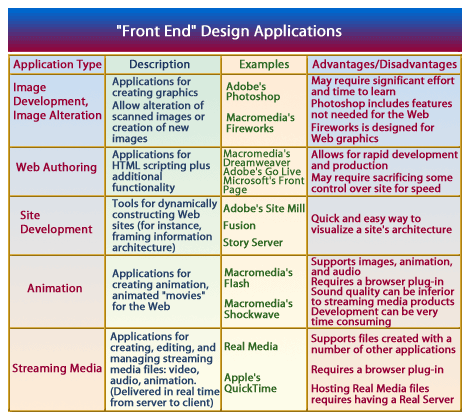| Lesson 5 | Front-end/back-end applications |
| Objective | Differentiate between front-end and back-end Applications |
Front-end and Back-end Applications
Deployment Oriented Applications
Most applications fall into the category of either deployment-oriented applications or design and development applications.
Deployment-oriented applications are applications that are used in deploying or running a Web site on a daily basis.
These applications are functionally oriented, and are applied to specific functional areas. Deployment applications are usually bought off the shelf, and require only minor customization. Examples of typical deployment applications are:
These applications are functionally oriented, and are applied to specific functional areas. Deployment applications are usually bought off the shelf, and require only minor customization. Examples of typical deployment applications are:
- Accounting (such as Accounts Receivable, for example, PeachTree and Payroll)
- Human resources (such as job applicant tracking or online benefits administration)
- Web metrics (such as tracking site visitation and usage, for example, WebTrends)
- Web server software (such as IIS or Apache)
- Personalization applications (such as Personify)
Front-end Design Applications
You will hear a lot about front-end vs. back-end activities. Similar to the terms front-office and back-office, these terms identify user vs. system level activities. Front-end design applications are used to create Web resources such as images, animation, and streaming multimedia, and to manage these resources. They are used by creative people in the front office. Common front-end design and development applications are shown in the table below.
Table Information
This table contains a great deal of information, but don't be overwhelmed.
You will undoubtedly be familiar with at least some of the applications and functions that are described. Read carefully through each row to learn about some of the industry standard design applications.
You will undoubtedly be familiar with at least some of the applications and functions that are described. Read carefully through each row to learn about some of the industry standard design applications.
Table 5.4 Front End Design Applications

Back-end Design and Development Applications
Back-end design and development applications are used to develop new, customized applications that are then used in the deployment environment. These applications, developed by programmers in the back office, are used in cases where the Web team decides to build
(or customize) an application, rather than buy a ready-made application. Many back-end development applications include the ability to dynamically generate HTML pages. Common back-end design and development applications include the following:
Data modeling tools
Data modeling tools are tools that help to model and then create a database application. A sample data-modeling tool is Rational Rose.
CASE tools
Computer-aided software engineering tools are tools that help to model and construct a business application, such as Human Resources applications. CASE tools are programs that write programs. They use humans to define the constraints and logical flow of events, then the CASE turns it into a bug-proof program.
Internet application development environments
Internet application development environments (a combination of tools and GUI) are specially designed for creating Web-based applications.
Popular examples of this powerful type of tool are Microsoft's InterDev and Fusion.
Question: What is the difference between Web Authoring and Site Development Software?
Answer: Web authoring is focused more on the design and function of individual pages, whereas site development focuses on the information architecture, storyboarding and content management of the site: how content is organized, stored, loaded, and how pages are connected or related. In the next lesson, you will learn about some examples of middleware and the benefits they bring to the Web system.
Question: What is the difference between Web Authoring and Site Development Software?
Answer: Web authoring is focused more on the design and function of individual pages, whereas site development focuses on the information architecture, storyboarding and content management of the site: how content is organized, stored, loaded, and how pages are connected or related. In the next lesson, you will learn about some examples of middleware and the benefits they bring to the Web system.
Software Architecture